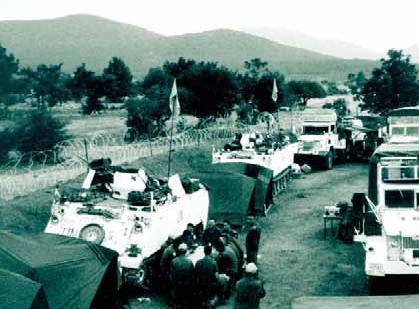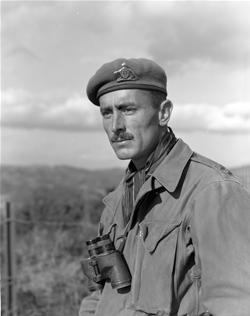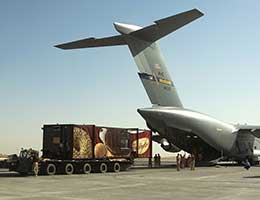Canada Remembers Times - 2013 Edition - Page 4
Canadian Peacekeepers Under Fire in Cyprus

Canadian soldier with local children during quieter times in Cyprus in 1965.
(Photo: Department of National Defence ZK-2057-4)
From 1964 to 1993, large numbers of Canadian Armed Forces members served in Cyprus, working to maintain an uneasy peace between the Greek and Turkish populations of the Mediterranean island.
In 1974, the situation boiled over when 40,000 troops from Turkey invaded Cyprus and active fighting broke out. In the days following the invasion, Canadian United Nations peacekeeping troops suddenly found there was no peace to keep. On July 23, 1974, in the midst of this chaos, a group of Canadian soldiers came under fire in a rocky gully. Several men were hit, including the officer leading the patrol. Private Joseph Plouffe went at once to try to give the injured officer first aid but was wounded as well. The two injured Canadians were left in a very vulnerable position and threatened by machine gun fire. Corporal Joseph Whelan and Privates Joseph Belley and Joseph Pelletier would not leave their comrades and braved the shooting to rescue the wounded men.
The Medak Pocket

Princess Patricia’s Canadian Light Infantry Battle Group - CANBAT 1 - Croatia 1993.
(Photo: Department of National Defence)
After its communist government was toppled in the early 1990s, Yugoslavia was torn apart by ethnic and religious differences. Civil war erupted and atrocities were committed on all sides. Canada and the international community sent in peace support forces, but the fighting continued.
In September 1993, soldiers of Princess Patricia’s Canadian Light Infantry were near the “Medak Pocket.” This portion of Croatia was under Serbian control and the Croatians had launched an offensive to re-take the area. A ceasefire was arranged, with United Nations (UN) forces to oversee the withdrawal of both sides. Canadian and French soldiers began to move in, but Croatian forces started firing. The Patricias held their position through the night in the face of the heaviest combat a Canadian unit had then experienced since the Korean War. Examples of courage were many, like Sergeant Rod Dearing of British Columbia who led his outnumbered platoon as they drove off repeated Croatian assaults and Private Scott LeBlanc, a young reservist from Nova Scotia, who unleashed heavy machine-gun fire to help repulse one last attack.
The next morning, the Croatians still prevented UN troops from entering the area. The Canadian commander, Lieutenant-Colonel James Calvin, held an impromptu press conference in front of their roadblock, embarrassing the Croatians into opening the road. Tragically, the UN forces found the ethnically Serbian villages in the Medak Pocket destroyed and many civilians killed—victims of “ethnic cleansing.”
The Man Called “JADEX”

Jacques Dextraze during the Korean War.
(Photo: Department of National Defence)
Canada has produced many great military leaders over the years. One of the best was Jacques Dextraze—also known as “Mad Jimmy” or “JADEX” to his men. Born in Montréal in 1919, he enlisted as a private during the Second World War and rose quickly through the ranks to command the Fusiliers Mont-Royal regiment by war’s end.
The Korean War would see him commanding the 2nd Battalion of the Royal 22e Régiment, which served bravely in actions like the heavy fighting at Hill 355 in November 1951. In the early 1960s, he commanded the United Nations peacekeeping mission in the Congo where he personally led a number of dangerous rescue missions of civilians held hostage by rebels. Dextraze continued to serve on his return to Canada, eventually being appointed Chief of the Defence Staff in 1972. He worked in this top military post until his retirement in 1977 as one of Canada’s most decorated and well-respected soldiers.
“A Taste of Home”

Tim Hortons mobile coffee shop arriving in Afghanistan in 2006.
(Photo: Department of National Defence AR2006-H044-0018a)
Ron Joyce was born in rural Nova Scotia in 1930. He moved to Hamilton, Ontario, at just 16 years of age, in search of greater opportunities with just $35 in his pocket. He enlisted in the Royal Canadian Navy in 1951 during the Korean War. He received training in communications and served off the coast of Korea and Japan after the Armistice.
After leaving the Navy, Joyce moved back to Hamilton where he became a police officer. He frequented a coffee shop on his daily foot patrols and befriended the owner, Tim Horton—a Canadian hockey legend.
Joyce’s entrepreneurial spirit emerged, and he and Tim Horton became full partners in the business. Today, Tim Hortons is one of Canada’s most successful brands, with the words “Timbit” and “double-double” being part of our national vocabulary!
In recent years, Canadian Armed Forces members serving in Afghanistan and numerous military bases have even been able to enjoy a little taste of home in special Tim Hortons outlets.
Operation Attention in Afghanistan

Canadian Armed Forces officer working with Afghan soldiers during
a training exercise in December 2012.
(Photo: Department of National Defence IS2012-2007-052)
More than 40,000 Canadian Armed Forces members have served in Afghanistan and on the waters off Southwest Asia since late 2001.Their duties have been dangerous and 158 of our brave men and women in uniform have given their lives over the years.
The combat phase of our mission in Afghanistan ended in July 2011, but up to 950 Canadian Armed Forces members have remained in the country to assume an important new role. Today, as part of Operation Attention, they contribute to a North Atlantic Treaty Organization (NATO) training program to help prepare the Afghan police, army and air force so they will be able to improve the security of their own country. Our military’s contribution to this multinational effort is currently centred in the capital city of Kabul and is scheduled to conclude in 2014. It will be an end of a mission that has brought a renewed national awareness of the great sacrifices and achievements made by Canadian Armed Forces members.
Crossword Puzzle
Did you read the newspaper stories carefully? All the answers to the crossword clues are found in the newspaper.
Use the clues to fill in the correct answers, one letter per square, both across and down.

Across
- 2. Name of the “Pocket” in Croatia where Canadian soldiers came under fire in September 1993 (5 letters).
- 3. Name of the Italian town where David Greyeyes earned a medal for bravery in the Second World War (6 letters).
- 6. Birth city of Canadian military officer Jacques Dextraze (8 letters).
- 9. Last name of the last Canadian killed in combat during the First World War (5 letters).
- 10. Fierce battle for which members of PPCLI were awarded an American decoration for bravery in Korea (7 letters).
- 11. Name of the ridge where the Allies set off some 20 large underground explosions on June 7, 1917 (8 letters).
- 12. Name of the boot company commissioned by the Canadian Army to produce its military footwear during the Second World War (6 letters).
Down
- 1. River in Korea where Canadian soldiers played hockey matches during the war (5 letters).
- 4. Name of the ship that took a direct hit on October 2, 1952 (8 letters).
- 5. Canadian city where Ron Joyce became a police officer (8 letters).
- 7. Name of the famous performers from the 3rd Canadian Division who entertained the troops in the First World War (8 letters).
- 8. Name of the ferry torpedoed on October 14, 1942, off the coast of Newfoundland (7 letters).
- Date modified: